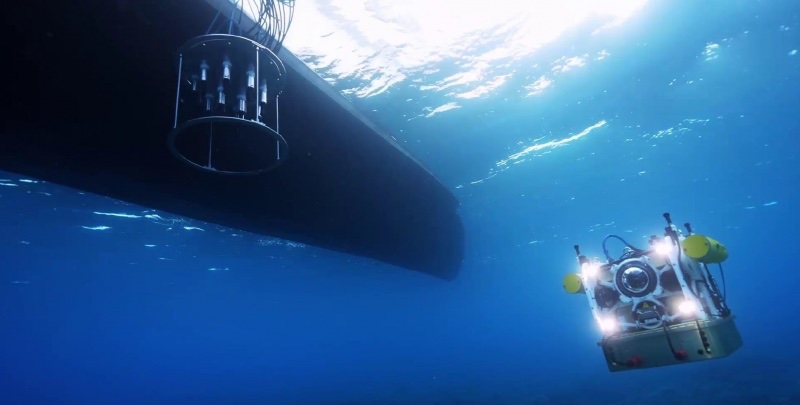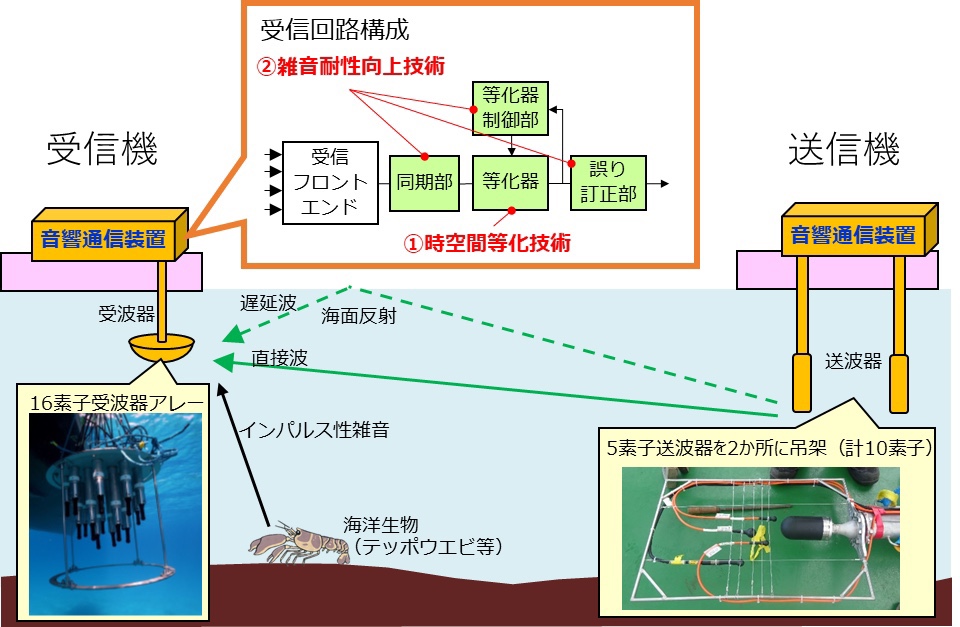

NTT: 1Mbps/300m wireless underwater drone!
ー1Mbps/300m Underwater Acoustic Communication Technologyー
– 10 times the communication speed of wireless underwater drones –
NTT Network Innovation Laboratories:
Developed “underwater acoustic communication technology of 1 megabit per second”.
The communication speed has improved more than 10 times compared to the conventional one.
In noisy shallow waters,
up to 300 meters away
Images can be sent in real time.
Wireless underwater drones are used for “fish reef management and offshore wind power generation maintenance”.
Shizuoka City
Marine demonstration field
A demonstration experiment is underway at the marine demonstration field in Shizuoka City.
“Noise removal technology such as reflected waves from the sea surface” has expanded the communication capacity.
Noise reduction technology:
in the shallow sea,
Reflected waves from the surface and bottom of the sea,
The menacing sound of the teppo shrimp
It becomes noise in acoustic communication.
Therefore, 16 wave receivers are arranged to form an array.
Eliminates reflected waves and extracts only signals that reach directly.
Impulse noise removal:
not the angle of the antenna,
“Extracting the signal from the direction of the sender by signal processing”
“The threatening sound of the giant shrimp is 10,000 times louder than the signal wave.”
We implemented a circuit to remove this impulse noise.
1 megabit per second:
You can work while watching underwater drone images at 1 Mbit / 300 m per second.
Currently, wired drones are mainstream and difficult to use.
Recommended Wireless Underwater Drones:
Until now, communication cables have been caught in fishing gear, etc.
Handling the cables was even more difficult than controlling the drone.
Wireless technology makes it easier to use for fishing and maritime infrastructure maintenance.
Promote commercialization with NTT DoCoMo and NTT Communications.
new switch
NTT : drone sous-marin sans fil 1Mbps/300m !
ーTechnologie de communication acoustique sous-marine 1Mbps/300mー
– 10 fois la vitesse de communication des drones sous-marins sans fil –
Laboratoires d’innovation du réseau NTT :
Développement d’une “technologie de communication acoustique sous-marine de 1 mégabit par seconde”.
La vitesse de communication s’est améliorée plus de 10 fois par rapport à la vitesse conventionnelle.
Dans les eaux peu profondes et bruyantes,
jusqu’à 300 mètres
Les images peuvent être envoyées en temps réel.
Les drones sous-marins sans fil sont utilisés pour « la gestion des récifs piscicoles et la maintenance de la production d’énergie éolienne offshore ».
Ville de Shizuoka
Champ de démonstration maritime
Une expérience de démonstration est en cours sur le terrain de démonstration marine de la ville de Shizuoka.
“La technologie d’élimination du bruit telle que les ondes réfléchies par la surface de la mer” a élargi la capacité de communication.
Technologie de réduction du bruit :
dans la mer peu profonde,
Les vagues réfléchies par la surface et le fond de la mer,
Le son menaçant de la crevette teppo
Il devient du bruit dans la communication acoustique.
Par conséquent, 16 récepteurs d’ondes sont agencés pour former un réseau.
Élimine les ondes réfléchies et extrait uniquement les signaux qui atteignent directement.
Suppression du bruit impulsif :
pas l’angle de l’antenne,
“Extraire le signal de la direction de l’expéditeur par traitement du signal”
“Le son menaçant de la crevette géante est 10 000 fois plus fort que l’onde de signal.”
Nous avons mis en place un circuit pour supprimer ce bruit impulsionnel.
1 mégabit par seconde :
Vous pouvez travailler tout en regardant des images de drones sous-marins à 1 Mbit / 300 m par seconde.
Actuellement, les drones filaires sont courants et difficiles à utiliser.
Drones sous-marins sans fil recommandés :
Jusqu’à présent, les câbles de communication étaient pris dans les engins de pêche, etc.
Manipuler les câbles était encore plus difficile que contrôler le drone.
La technologie sans fil facilite son utilisation pour la pêche et la maintenance des infrastructures maritimes.
Promouvoir la commercialisation avec NTT DoCoMo et NTT Communications.
nouvel interrupteur
NTT: 1Mbps/300m drahtlose Unterwasserdrohne!
ー1Mbps/300m Akustische Unterwasserkommunikationstechnologieー
– 10-fache Kommunikationsgeschwindigkeit von drahtlosen Unterwasserdrohnen –
Innovationslabore des NTT-Netzwerks:
Entwickelte “akustische Unterwasserkommunikationstechnologie von 1 Megabit pro Sekunde”.
Die Kommunikationsgeschwindigkeit hat sich im Vergleich zur herkömmlichen um mehr als das Zehnfache verbessert.
In lauten seichten Gewässern,
bis zu 300 Meter entfernt
Bilder können in Echtzeit gesendet werden.
Drahtlose Unterwasserdrohnen werden für das „Fischriffmanagement und die Wartung von Offshore-Windkraftanlagen“ eingesetzt.
Shizuoka-Stadt
Marine-Demonstrationsfeld
Auf dem Meeresdemonstrationsfeld in der Stadt Shizuoka ist ein Demonstrationsexperiment im Gange.
“Rauschentfernungstechnologie wie reflektierte Wellen von der Meeresoberfläche” hat die Kommunikationskapazität erweitert.
Rauschunterdrückungstechnologie:
im seichten Meer,
Reflektierte Wellen von der Meeresoberfläche und dem Meeresboden,
Der bedrohliche Klang der Teppo-Garnelen
In der akustischen Kommunikation wird es zum Rauschen.
Daher werden 16 Wellenempfänger angeordnet, um ein Array zu bilden.
Eliminiert reflektierte Wellen und extrahiert nur Signale, die direkt ankommen.
Entfernung von Impulsrauschen:
nicht der Winkel der Antenne,
“Das Signal aus der Richtung des Senders durch Signalverarbeitung extrahieren”
„Das bedrohliche Geräusch der Riesengarnele ist 10.000 Mal lauter als die Signalwelle.“
Wir haben eine Schaltung implementiert, um dieses Impulsrauschen zu entfernen.
1 Megabit pro Sekunde:
Sie können arbeiten, während Sie Unterwasser-Drohnenbilder mit 1 Mbit / 300 m pro Sekunde betrachten.
Derzeit sind kabelgebundene Drohnen Mainstream und schwer zu bedienen.
Empfohlene drahtlose Unterwasserdrohnen:
Bisher haben sich Kommunikationskabel in Fanggeräten usw. verfangen.
Die Handhabung der Kabel war noch schwieriger als die Steuerung der Drohne.
Drahtlose Technologie erleichtert den Einsatz für die Fischerei und die Wartung der maritimen Infrastruktur.
Fördern Sie die Kommerzialisierung mit NTT DoCoMo und NTT Communications.
neuer Schalter
Achieving 1-Mbps/300-m underwater transmission and wireless remotely operated vehicle (ROV)
using underwater acoustic communication
– Progress towards the Extreme Coverage Extension that 6G-IOWN is aiming for –
Press Release
NTT and DOCOMO
started considering applying these technologies to the Non-Terrestrial Network (NTN) (*4) for “5G Evolution & 6G powered by IOWN,”
and we have started study on extending coverage to underwater areas,
which have been unexplored for high-speed wireless communication.
In addition,
NTT, DOCOMO, and NTT Communications are
going to experiment in Shizuoka Prefecture in an underwater equipment inspection using this wireless ROV.
These technologies
will be introduced at the “NTT R&D Forum – Road to IOWN 2022” (*5) scheduled to be held from November 16 to 18, 2022.